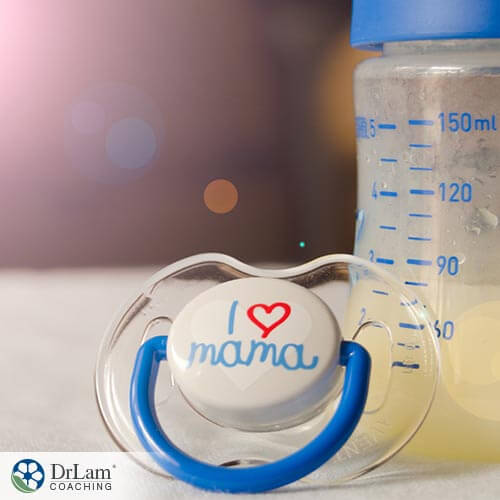 Nothing makes a difference in your appearance like healthy, radiant skin. And there’s a reason for that. Skin appearance is one of the most accurate ways we can tell how we’re doing on the inside; it’s one of the tools nature has given us to know when something is not going well in our bodies, especially in the gut. Colostrum, the “first milk” that is produced by mammals a few days before and a few days after giving birth, is an excellent way to improve the way your skin looks from the inside out. You need to start on the inside, because no matter how many different products you use topically, if your internal health is not in top form, they won’t make much of a difference.
Nothing makes a difference in your appearance like healthy, radiant skin. And there’s a reason for that. Skin appearance is one of the most accurate ways we can tell how we’re doing on the inside; it’s one of the tools nature has given us to know when something is not going well in our bodies, especially in the gut. Colostrum, the “first milk” that is produced by mammals a few days before and a few days after giving birth, is an excellent way to improve the way your skin looks from the inside out. You need to start on the inside, because no matter how many different products you use topically, if your internal health is not in top form, they won’t make much of a difference.
Colostrum is that miracle fluid produced by mammalian breasts during pregnancy. It is the first meal many infants get if they are breastfed. Colostrum is now being studied in adults because of its nutritional and anti-inflammatory properties, among others.
Human females begin making colostrum about four months into a pregnancy. This is the liquid that leaks out of the breasts during pregnancy.
Bovine colostrum may contain factors that grow the immune system of their offspring and pass along a tremendous number of antibodies. Research has discovered that bovine colostrum contains 86 growth factors and 96 or more immune factors and transferable antibodies.
The growth factors serve to help the gut and other lean tissues develop and mature. This is especially beneficial for growing a healthy gut microbiome. The immune factors and transferable antibodies are vital for the infant to survive. These factors and antibodies have been developed by the mother over her lifetime of exposure to pathogens for which the developing infant would otherwise have no protective antibodies.
These compounds are suited for human use, as well. They are not species specific. That means you can get many of the same colostrum benefits from bovine colostrum as a calf can.
The gut, which is composed of several organs that work together as a system, is around 30 feet long and around 3000 square feet. That’s the size of two tennis courts! It contains two-thirds of your immune system cells, called the Gut-Associated-Lymphoid-Tissue (GALT), and it produces around 30 different hormones. It has a direct effect on the brain, through gut-brain communication.
The lining of the wall of the intestine (the gut) is only one cell thick. These cells are held and “glued” together tightly when the gut is healthy. This prevents materials, such as bacteria, viruses, food particles, and other organisms, from crossing that barrier between two cells (known as the tight junction) and causing inflammation in the rest of the body. Keeping these tight junctions healthy is vital.
Meanwhile, the skin is the largest single organ of the body, taking up around 16% of your body weight and around 18 square feet. It sweats as a way to keep your body temperature stable and to get rid of toxins. A normal amount of sweat can be up to a quart a day.
The skin has four different types of receptors for different types of pressure. The Pacinian receptors respond to vibration, the Merkel receptors respond to texture, the Meissner receptors respond to light touch, and the Ruffini receptors respond to pressure from stretching. Pain and temperature signals are received from the millions of nerve endings in your skin.
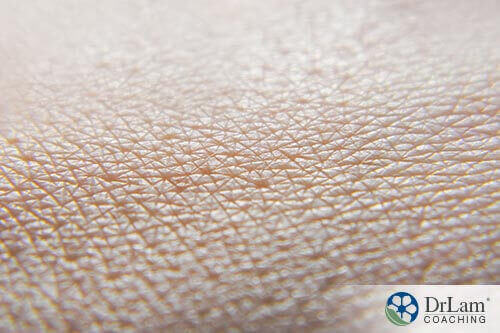 Skin turnover can be anywhere between 20 and 28 days, though as you get older, it can take up to 40 days. Certain skin treatments can help with this issue, but most are not able to completely prevent the look of aging skin.
Skin turnover can be anywhere between 20 and 28 days, though as you get older, it can take up to 40 days. Certain skin treatments can help with this issue, but most are not able to completely prevent the look of aging skin.
In order to assess skin aging, there are several components to look at, including genetics, cellular metabolism, immune function, and hormones. And all of these components can be influenced by improving gut health.
The skin and the gut have striking similarities. First of all, their surface cells are responsible for a crucial function: they protect you from the environment, while still allowing you to absorb what you need and excrete what you don’t need.
The gut and the skin have very large surface areas, and they are both populated with the millions of bacteria that form the skin microbiome and the gut microbiome. Generally, if you are healthy, your organs and their microbiota live in harmony, and it is only when that harmony is disturbed that you get bacteria-based problems.
Inflammation almost always begins in the gut, due to the presence of such a large portion of your immune cells there, as well as the damage to the epithelium that is becoming more and more common with the increasing prevalence of:
Exposure to these substances will affect the balance between the good and bad bacteria in the gut, which then also affects the tight junctions between the gut epithelial cells. These junctions are supposed to act like gates that only let into the bloodstream the nutrients derived from digestion while keeping out any other substances like food particles, toxins, and pathogens.
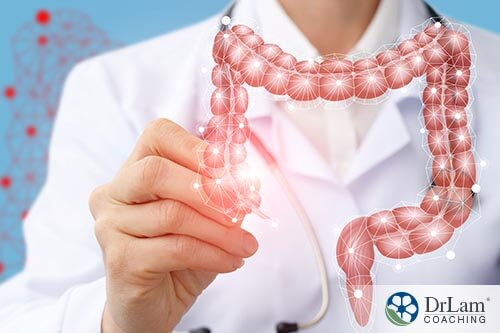 Meanwhile, when you are under significant, continuing stress, this lining can become damaged and more permeable, allowing the particles to cross over into enteric circulation and to the rest of the body. When this occurs, your body’s immune system is activated. It treats these materials that leaked through as foreign invaders and begin attacking them. Inflammation results.
Meanwhile, when you are under significant, continuing stress, this lining can become damaged and more permeable, allowing the particles to cross over into enteric circulation and to the rest of the body. When this occurs, your body’s immune system is activated. It treats these materials that leaked through as foreign invaders and begin attacking them. Inflammation results.
This inflammation becomes the foundation for numerous chronic illness conditions as it travels throughout the body in the bloodstream. It strikes organs, joints and muscles, and even the brain
When your gut microbiome is out of balance (dysbiosis), and the junctions between the epithelial cells widen, you can develop leaky gut syndrome. And each time you eat or take medications, the wrong substances end up in your bloodstream, causing an immediate immune response and subsequent inflammation.
These leaks remain and sometimes get worse if the causal factors are not addressed. This can create a state of constant inflammation, which spreads to other parts of the body, such as the joints, brain, and skin.
In short, inflammation is very toxic to your body. Colostrum contains compounds that can not only address inflammation directly but also help heal your leaky gut and stop more inflammation from occurring.
The leaky gut cycle can be triggered by something as simple as taking pain medications or antibiotics. This creates a state of dysbiosis and leaks, which then creates an immune response and inflammation, for which you take more pain meds or antibiotics, and leading to more dysbiosis and leaks.
The result can be conditions like arthritis, inflammatory bowel disease (IBD), obesity, diabetes, and a host of autoimmune diseases. The National Institute for Health has categorized 80 different conditions that result from autoimmunity. Some autoimmune conditions that are affected by leaky gut and dysbiosis include:
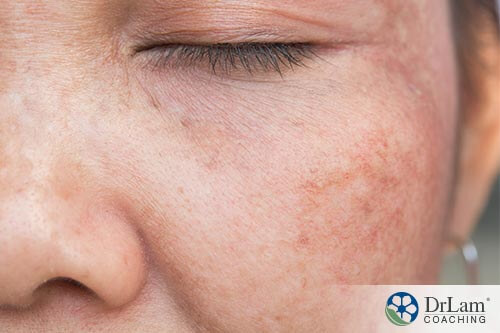
Where the cells on the surface of the skin build up due to having a faster-than-normal speed cycle, causing scales and itchy, red patches.
Dry, itchy skin that can show up in red or gray patches that can become scaly, thick, and cracked. Some people get raised bumps that leak fluid and get crusty.
Although lupus affects many different organs, it can also cause skin rashes and patches of redness that are especially sensitive to sunlight.
A chronic disease of the connective tissues that can create a hardening of the skin.
A rare inflammatory condition that affects muscles and skin, creating skin rashes that are very distinct and that usually develop on the face, eyelids, and knuckles.
This group of genetic conditions makes the skin very fragile and susceptible to bruising, and it can create blisters and erosions in response to friction or injury to the skin.
Although different studies will claim opposing opinions on the role of the diet in skin conditions, especially with acne, the weight of evidence shows that gut health is a huge factor in skin health. For example, in one study, a group of males between the ages of 15 and 25 was put on a low-sugar diet. They showed a significant improvement in both total and inflammatory lesions.
An age and gender-adjusted study of 101 patients, 49 with acne and 52 with normal skin, looked at their P. acnes bacteria. They found two strains in 20% of the acne patients, while the acne-free patients only had the third strain (which was a “good” bacteria as opposed to the other two).
Patients with rosacea (a long-term condition that creates redness, swelling, dilation of the tiny blood vessels in the skin, and pimples on the face) are five to ten times more likely to also suffer from Small Intestinal Bacterial Overgrowth (SIBO) than healthy controls. The most common areas of the face affected are the nose, forehead, cheeks, and chin.
SIBO is a potentially dangerous health issue because it can lead to malabsorption. When there are too many bacteria in the small intestines, they can interfere with digestion and end up consuming most of the nutrients and energy from the food you are eating, leaving you with little left to absorb. And although it is usually treated with antibiotics, that treatment can create more problems further down the line.
Certain supplements, such as oregano oil and probiotics, can help with SIBO, as well as cutting out any allergenic foods. Interestingly enough, scleroderma can actually be a contributing factor to SIBO, showing how the gut-skin axis works both ways.
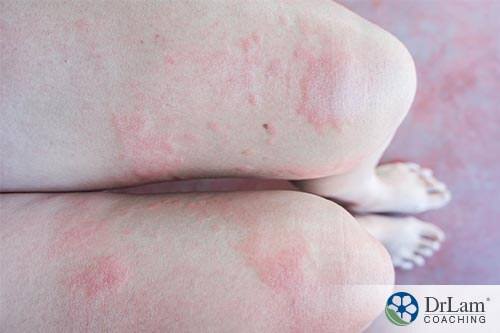 Adrenal Fatigue Syndrome (AFS) can affect the skin, making it dry, and sometimes itchy. Plus, some of the causal factors of inflammatory skin conditions, like dysbiosis, leaky gut, and inflammation, are also common with AFS. At the same time, AFS can trigger or aggravate these factors.
Adrenal Fatigue Syndrome (AFS) can affect the skin, making it dry, and sometimes itchy. Plus, some of the causal factors of inflammatory skin conditions, like dysbiosis, leaky gut, and inflammation, are also common with AFS. At the same time, AFS can trigger or aggravate these factors.
AFS happens when you are under chronic stress, whether physical, such as from infections, diseases, or injuries, or psychological stress. Your adrenal glands begin to secrete anti-stress hormones, especially cortisol, in order to deal with that stress.
But the longer the stress continues, the more likely the adrenals will weaken and you will begin to experience the symptoms of adrenal fatigue, such as fatigue, weight gain, insomnia, lowered immunity, mild depression, anxiety, brain fog, low libido, PMS, infertility, an inability to handle stress, and occasional heart palpitations.
Some symptoms will show on your face. For example, the lack of sleep can create dark circles under your eyes, and the fatigue will make you less likely to be physically active, which reduces circulation to the skin, making it more dull or pale.
Dry skin is another symptom of AFS, and it is related to the secretion of aldosterone by the adrenals. Aldosterone is responsible for the balance between sodium and potassium in your body, as well as for hydration. It can decrease when your adrenals are weak. Less aldosterone equals less hydration, and that results in dry skin.
In some people with AFS, estrogen and progesterone levels will be out of balance as well, which can also create dry skin. If the progesterone levels are too low in relation to estrogen, that’s called estrogen dominance, which causes acne as well.
AFS is also closely linked to thyroid function, and when the thyroid is not working properly, dry skin can develop. And when the adrenals are weak, your pituitary gland will sometimes try to compensate by producing more corticotropin to stimulate them, and too much corticotropin can increase pigmentation, creating dark patches on the skin.
The adrenals and thyroid are part of the hormonal and metabolic circuits of your body’s NeuroEndoMetabolic (NEM) Stress Response, which is how your body responds to stress. However, the entire NEM can become dysregulated if stress and inflammation are not managed properly. The NEM’s inflammation response can wreak havoc on skin health as well as overall health, and it is tied to the NEM’s detoxification response.
The skin is a major factor in the detoxification response. Just underneath the skin is an organ known as the interstitium. The interstitium is a reservoir of fluid and is responsible for the transportation of nutrients throughout the body. It drains into the lymphatic system and plays a part in helping your body detoxify.
If your body is not detoxifying properly, due to congestion in your liver or interstitium, then toxins and metabolic by-products can build up in your body. The skin will do its best to get rid of toxins through sweat, but it can’t handle the load on its own, and will eventually show signs of toxicity and congestion as well.
Doing a detox can help with that, but if you have advanced AFS, you’ll need to be careful not to stress your body too much. The adrenal fatigue diet is already very clean and can strengthen your adrenals so you can handle more detoxing, and it will also address the key factor in beautiful skin: gut health. Adding bovine colostrum to the mix can give your gut and skin the extra boost it needs to heal from preexisting conditions and restore your health.
 Colostrum may help your skin by having an effect on what is considered to be the cause of aging in some circles - oxidative stress.
Colostrum may help your skin by having an effect on what is considered to be the cause of aging in some circles - oxidative stress.
Your skin is made up of the epidermis, which is the outer layer, and the dermis below it, and they are held together by the basal lamina. Skin aging shows up differently depending on which layer is affected. It also depends on whether your skin is going through intrinsic or extrinsic aging. Although everyone experiences both types, the degree of each varies from person to person.
Oxidative stress can affect both intrinsic and extrinsic aging because it increases naturally with age. In fact, oxidative stress is one of the main theoretical causes of aging, and so it is a major component in intrinsic skin aging. But because it can be accelerated through environmental exposure, it can be part of extrinsic skin aging as well.
The main reason to avoid UVA and UVB exposure is that it induces the production of free radicals, which damage the proteins in the skin, damage the DNA, and disrupt the mitochondria. An excess of free radicals relative to the molecules that fight them, the antioxidants, is what causes oxidative stress.
Being the largest organ and in direct contact with the environment, the skin is especially susceptible to oxidants and catalysts that can produce reactive oxygen species (free radicals), as well as reactive nitrogen species.
Free radicals are natural byproducts of many different processes of the system, they are molecules that have unpaired electrons, and so are unstable. As they circulate in the system, they encounter stable molecules, and essentially steal elections from them in order to become stabilized themselves. This makes the molecules they encounter become unstable, and so they also end up needing to steal electrons from other molecules.
The body is equipped to handle free radicals through the use of antioxidants, which donate electrons to the free radicals and interrupt the chain reaction of electron stealing. But if there are too many free radicals, your body can’t fight them all off, and you get oxidative stress.
Oxidative stress in the skin leads to inflammation, and this inflammation fragments collagen, disorganizes its fibers, and disrupts the function of skin cells. This can contribute to different types of skin diseases, including cancer and accelerated aging.
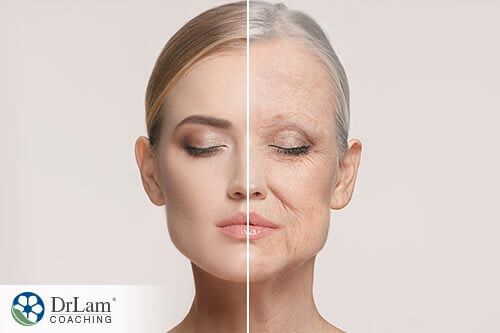 Intrinsic skin aging typically involves a thinning of the epidermis, the outermost layers of skin cells, and a loss in the rete ridge definition. Rete ridges, which are also called papillae, are the extensions from the epidermis that reach down to the connective tissue underneath.
Intrinsic skin aging typically involves a thinning of the epidermis, the outermost layers of skin cells, and a loss in the rete ridge definition. Rete ridges, which are also called papillae, are the extensions from the epidermis that reach down to the connective tissue underneath.
Also, the rate of turnover of skin cells slows as you get older. The skin also starts to lose its sensitivity due to a decrease in the number of nerve endings and a reduction in sex hormone production. Generally, as you age, your skin gets drier as well, which is further exacerbated if you have adrenal fatigue.
Although it isn’t always the case, generally, your adrenals can be more easily fatigued with age, as there can be a build-up of inflammation and other health conditions that overwork the adrenal glands and the NEM stress response. This is why it’s becoming more and more crucial to take proactive care of your health as the stresses of modern living intensify.
With extrinsic skin aging, which is accelerated by environmental conditions, such as UV-radiation (also called photo-aging), the skin can actually get thicker instead of thinner, and its composition begins to change. Avoiding harmful environmental factors and using natural skin creams and serums can mitigate extrinsic skin aging, but taking a holistic approach is always best as it can slow down both types of aging.
In both intrinsic and extrinsic aging, the extracellular matrix (ECM), including the interstitium, is the key factor in the aging of the dermis, which is the layer underneath the epidermis, and it can result in the reduction of collagen, hyaluronic acid, and elastic fibers. This can create the appearance of fine lines and wrinkles. That’s because the interstitium enzymes are what process collagens, elastic fibers, and the proteoglycans that are found in connective tissues.
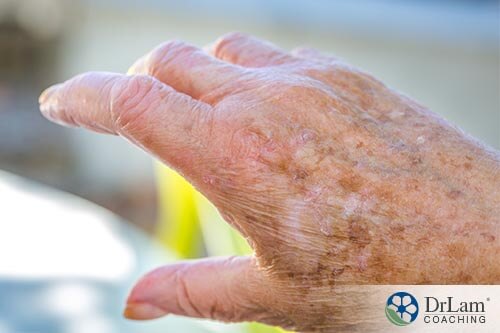 Keeping the interstitium clear, or doing a detox that focuses on interstitial health, can be one way to maintain skin health. But again, it is important to do so under supervision and not when you are in a debilitated state, such as in advanced stages of AFS. Better to start with cleaning up your diet slowly first, perhaps adding some colostrum to it, and strengthening your adrenals, before doing a detox that could potentially lead to a crash and a worsening of your condition.
Keeping the interstitium clear, or doing a detox that focuses on interstitial health, can be one way to maintain skin health. But again, it is important to do so under supervision and not when you are in a debilitated state, such as in advanced stages of AFS. Better to start with cleaning up your diet slowly first, perhaps adding some colostrum to it, and strengthening your adrenals, before doing a detox that could potentially lead to a crash and a worsening of your condition.
In order to heal skin issues, you need to build and repair it from the inside out. Inflammation and stress play a role, and healing the gut is essential for healthy, beautiful skin. But how do you know where you should put your focus?
There are a few tests to check if your gut is in need of special attention, including a stool test and an immunological blood test. These tests can show whether you have bacteria, parasites, or candida, and they can check whether you have a leaky gut.
Depending on the results, you can develop a diet and supplements plan tailored to your needs. In general, an anti-inflammatory diet rich in probiotics and prebiotics will be useful whether or not you have a leaky gut or other gastrointestinal conditions. You might want to consider taking a digestive enzyme and testing the levels of hydrochloric acid your stomach produces in case you need extra support for digestion.
 Supplementing with bovine colostrum may be a great option if you want to heal your skin, as it can provide nucleotides, immune factors, and certain growth factors that are needed to build and repair the skin. Some of its beneficial aspects include:
Supplementing with bovine colostrum may be a great option if you want to heal your skin, as it can provide nucleotides, immune factors, and certain growth factors that are needed to build and repair the skin. Some of its beneficial aspects include:
EgF stimulates growth and differentiation of epidermal and dermal cells. Along with the EgF receptor, it plays a crucial role in wound healing. In fact, EGF is the growth factor that will help repair gut lining tissue. EgF receptor inhibitors are also used in certain cancer treatments.
There are two classes that fall under TgF: TgF-alpha, which binds the EgF receptor and activates cell growth and differentiation of the endothelial cells, and TgF-beta, which initiates a signaling pathway that inhibits the growth of cancer cells.
FgFs and FgF receptors regulate cellular proliferation, differentiation, and migration, and have been implicated in tissue regeneration in in vitro studies.
IGF-1 may be the most important factor in bovine colostrum that affects aging. It is one of the most potent ways to activate the AKT signaling pathway. This pathway stimulates cell growth and proliferation while also inhibiting programmed cell death. Thus, it helps fight the metabolic effects of aging. The IGF-1 in bovine colostrum helps increase lean muscle mass and bone density, and aids in tissue regeneration.
IgF-1 is also a hormone with a similar structure to insulin. It supports childhood growth and has anabolic effects (helping with muscle growth and stimulating protein synthesis) in adults. The IgF-1 that is present in bovine colostrum is not absorbed directly by the human body, but it can stimulate the production of the body’s own IgF-1.
These compounds are messenger factors, microscopic molecules that communicate information regarding immunity from organism to organism. This information helps the receiving organism learn about immune threats, either internal or external, and how to respond properly. The transfer factors pass this information from immune cell to immune cell.
These transfer factors apparently contain RNA and proteins, but not DNA. They are small and non-allergenic. Taken orally, they retain full potency. One of the colostrum benefits for all mammals is the ability of newborns to take in these transfer factors and have passive immunity for any of the pathogens experienced by the mother.
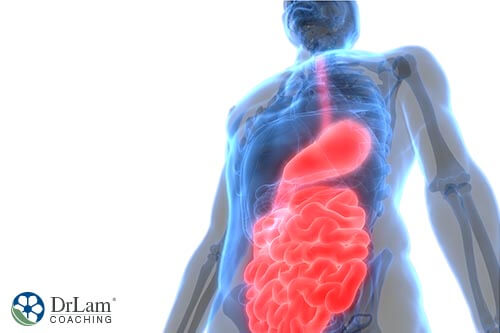 Bovine colostrum has been researched extensively and found to be a safe and viable source of colostrum with transfer factors for human consumption. This is important due to the fact that the growth and immune factors in bovine colostrum are similar to those in human colostrum. One of the bovine colostrum benefits is the presence of glycoproteins and protease inhibitors that work to protect the active factors in colostrum from the destructive effects of the human digestive system.
Bovine colostrum has been researched extensively and found to be a safe and viable source of colostrum with transfer factors for human consumption. This is important due to the fact that the growth and immune factors in bovine colostrum are similar to those in human colostrum. One of the bovine colostrum benefits is the presence of glycoproteins and protease inhibitors that work to protect the active factors in colostrum from the destructive effects of the human digestive system.
Immunoglobulins are one of the transfer factors in the multitude of colostrum benefits. They are the primary active components of bovine colostrum and serve several purposes. They help to keep the immune system balanced, regulate the thymus which is a key factor in the immune system, help control inflammation nutritionally, and help protect against allergic reactions.
Only 2 percent of this immunoglobulin is found in human colostrum. But bovine colostrum contains 38 percent, specifically a protein antibody, IgG. This is an important immunoglobulin whose effectiveness has been proven against many microorganisms, some of which have developed resistance to current antibiotics.
Bovine colostrum also contains protease inhibitors that prevent the enzymes in the human digestive system from destroying the immunoglobulins. This lets the immunoglobulins go directly to the bowel where they adhere to the mucosal lining and produce antibodies.
Lactoferrin is also effective in fighting viruses and bacteria. Studies of MS subjects showed a positive response to the use of colostrum rich in IgA. No side effects were reported by these subjects. MS is one of those chronic illness conditions that is triggered or exacerbated by viruses.
Lactoferrin has been shown to aid in restoring the humoral immune response, mediated by T and B cells. Viral and bacterial infections have been reduced in the presence of lactoferrin in immunocompromised subjects. This finding may be important in reducing possible triggers for autoimmune chronic illness conditions.
Studies have also shown lactoferrin to slow the production of proinflammatory cytokines such as tumor necrosis factor alpha and interleukin 1-beta, a biological marker that can be elevated in inflammatory states. Inhibiting these proinflammatory cytokines is important in the remediation of autoimmune conditions in which inflammation increases pain responses.
Proline-rich polypeptides (PRP) aid and regulate the thymus gland, the “master gland” for immune responses. Research has shown the PRPs in colostrum help build up a suppressed immune response. On the other hand, if the immune response is overactive, these PRPs will help to balance it.
These PRPs, also known as colostrinin, help prevent overproduction of lymphocytes and aid in the production of helper and suppressor T cells. This is the mechanism by which they help balance an overactive immune response found often in AFS.
People with long-lasting infections or multiple, recurring infections and those with chronically depleted immune responses have benefited from colostrum along with beta 1/3, 1/6 glucan (derived from mushrooms).
One of the major benefits of PRPs is their tendency to stop the inflammatory response. If you have a leaky gut, one of the major harmful conditions that come with adrenal fatigue, inflammation can become rampant in your system. This is partially due to a TH2 cytokine response. This response produces white blood cells that attack and damage the fragile gut lining.
As long as these TH2 cytokines are present, you can regenerate cells in your gut lining, but the TH2 cytokines will just destroy them again. That makes healing leaky gut almost impossible. The PRPs in colostrum stop TH2 cytokine production but allow beneficial white blood cells to continue their work.
The combination of colostrum’s PRPs stopping TH2 cytokine production and the growth factors in colostrum helping rebuild the gut lining speeds healing of leaky gut. This is another of the colostrum benefits that helps you deal with AFS.
These are protein derivatives found in colostrum that have been found to reduce inflammation, swelling, pain, and fever. One clinical study showed people suffering from chronic rheumatoid arthritis and those experiencing treatment-resistant osteoarthritis obtained significant benefit from continued use of the infopeptides in colostrum. There were no reported side effects.
Used externally, these compounds help in reducing wrinkles in the skin that so often are some of the first signs of aging. Used internally, they aid in the healing of the lining of the gut. These are long-chain sugars and act as natural prebiotics that feed the beneficial bacteria in the gut and help keep the digestive system functioning at its optimum levels.
These hormones are naturally produced by the thymus gland. The thymus is a gland located in the center of your chest. At birth, it is roughly the size of your heart, but it gradually decreases in size as you age. There may be little left of the thymus by the time you’re a senior citizen. This is unfortunate because the thymus is important in the functioning of a healthy immune system. There is some evidence that bovine colostrum may help in regenerating this small but very important gland.
This is an enzyme found in milk and colostrum that functions as an antimicrobial agent. Its primary function is to prevent the growth of harmful bacteria. It also serves to fight gingivitis if it is allowed to dissolve in your mouth. Some evidence shows it may also regrow receding gum lines. Research suggests it also may assist in the consumption of cancer cells by white blood cells by stimulating them to do this.
Raw colostrum contains lactobacillus acidophilus, a beneficial bacteria that is important in the human immune system. When you take antibiotics, this causes an imbalance in your gut between good bacteria and those targeted by antibiotics, which essentially kill all bacteria. This imbalance shows up not only in your gut, but also in your skin, nose, throat, and mouth. Taking acidophilus helps by resupplying the gut with beneficial bacteria first, then overflows into other areas of your body. The naturally occurring prebiotics found in colostrum feed the acidophilus as well as other beneficial bacteria in your body.
Along with lactoferrin, this nutrient found in colostrum may help in balancing the playing field between men and women where aging is concerned. One theory explaining the shorter lifespan of men around the world has to do with the fact that men don’t have menstrual periods in which blood is shed regularly. This may be important because of excess iron that circulates in men’s blood. It basically gets “rusty” and may cause damage that can accumulate over time. This is due to oxidation; iron is a pro-oxidant in the body. Together, lactoferrin and hemopexin tend to bind to excess iron and remove it from the body.
 Found in higher amounts in bovine colostrum, nucleosides have a number of beneficial functions in the body. One of the important beneficial functions of nucleosides is their tendency to help modulate the immune system. They change the immune system to make it work more effectively, rather than simply increasing it. Just increasing the immune system could stimulate underlying autoimmune conditions. In addition, nucleosides also improve iron absorption in the body and help in the desaturation of fats that makes them easier to digest.
Found in higher amounts in bovine colostrum, nucleosides have a number of beneficial functions in the body. One of the important beneficial functions of nucleosides is their tendency to help modulate the immune system. They change the immune system to make it work more effectively, rather than simply increasing it. Just increasing the immune system could stimulate underlying autoimmune conditions. In addition, nucleosides also improve iron absorption in the body and help in the desaturation of fats that makes them easier to digest.
In addition to the above health benefits of colostrum for your body, there are also some more general ones. These include building and restoring your hormonal system back to levels you had in your youth. Another general benefit of colostrum is to strengthen your immune system so that it functions optimally. It also restores and repairs your digestive system. In addition, it provides many of the nutrients essential for your optimum health.
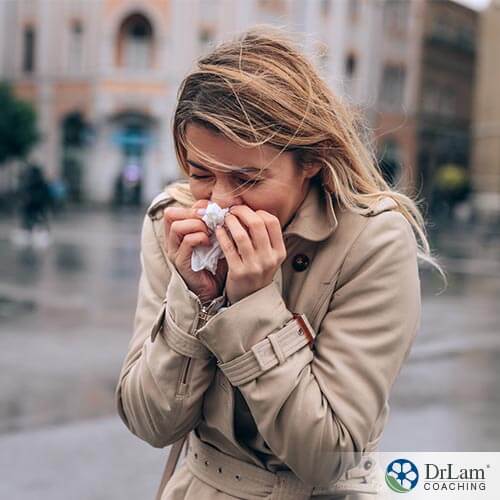 As colostrum is the first milk, it contains the antibodies that the newborn needs in order to build up immunity to have protection from infections and diseases. When used along with certain mushrooms, they form a powerful combination for enhancing the body’s overall immune system and optimizing the microbiome .
As colostrum is the first milk, it contains the antibodies that the newborn needs in order to build up immunity to have protection from infections and diseases. When used along with certain mushrooms, they form a powerful combination for enhancing the body’s overall immune system and optimizing the microbiome .
Colostrum transfers immune cells and antibodies such as immunoglobulin G (IgG), which is the most common type of antibody in the body’s circulation, from mother to baby. IgG makes up about two-thirds of serum antibodies in human beings and is the main component of humoral immunity.
Humoral immunity is an antibody-mediated immune response, which means it uses immunoglobulins that circulate in the blood and lymphatic system. Other than IgG, which is the longer-lasting and stronger humoral immune response, humoral immunity employs immunoglobulin M (IgM) as the briefer, and generally weaker, immune response. There are three other immunoglobulins (A, E, and D) that are also employed, though not as extensively.
Humoral immunity defends against viruses, toxins, parasites, allergies, and bacteria. For all mammals, IgG is transferred solely through the milk, and so without getting colostrum in the first few days of life, they die. Human babies are an exception as they can get IgG through the placenta, so in that sense, they can still build immunity, though not as efficiently as when they are given colostrum.
Tumor necrosis factor-alpha (TNF-alpha) has been implicated in several chronic conditions, including rheumatoid arthritis. Research from the Kennedy Institute of Rheumatology has shown the pro-inflammatory cytokines that cause so much trouble with rheumatoid arthritis to be reduced or stopped if the TNF-alpha is neutralized. People with both rheumatoid arthritis and Crohn’s disease benefit from TNF-alpha blockers.
Further research has shown colostrum to have TNF-alpha receptors which bind to and block TNF-alpha activity. This neutralization of TNF-alpha is possibly one of the mechanisms by which colostrum decreases these pro-inflammatory cytokines and improves the health of people suffering from several chronic debilitating illnesses.
Many of the colostrum benefits discussed thus far are also benefits for sufferers of adrenal fatigue syndrome (AFS). This condition is that resulting from continuing stress in the life of a person. Any time stress comes into the life of anyone, the same process occurs. The body is stimulated to release a cascade of hormones and chemicals in response to the stress. The adrenal glands release cortisol, the stress-fighting hormone, to counter the effects of stress. If the stress continues, the adrenals become fatigued and not able to secrete sufficient cortisol. This is when the symptoms of AFS begin. Ultimately, these symptoms can become so debilitating as to cause the person to become bedridden.
The most comprehensive and effective way to view these symptoms is from the NeuroEndoMetabolic (NEM) model of stress response. Rather than viewing symptoms alone or single organs in evaluating and remediating this condition of AFS, NEM proposes looking at six organ systems that interact in an interrelated manner. This viewpoint says what affects one of these organ systems affects all in some way. It allows more effective ways of assessing and dealing with symptoms of AFS. Traditionally trained medical professionals typically do not adhere to this model’s viewpoint and thus don’t successfully deal with the vague symptoms of AFS.
Although immunity begins in the gut, there are several other important functions the development of a healthy gut contributes to, and this is especially obvious in the development of the gastrointestinal system of newborns.
Newborn mammals are born with leaky guts, and this includes human babies. Colostrum helps to seal these leaks and balance out the microbiome. It also has a very high concentration of nutrients relative to its volume. That means it is nutrient-dense so that the newborn doesn’t need to consume large amounts or a variety of different foods in order to get the nutrients it needs for growth and health.
Bovine colostrum also contains lactoferrin. Lactoferrin binds to iron in the gut and keeps it away from bacteria. Many of the gram-negative bacteria in the gut need iron to survive, and so bovine colostrum can help with dysbiosis by keeping the iron away from the bad bacteria, giving the good bacteria a chance to balance out.
The theory is that if colostrum is safe and beneficial for newborns, it’s also safe and beneficial for adults suffering from leaky gut, dysbiosis, and those that have issues with absorption. There are also a few studies that corroborate this theory.
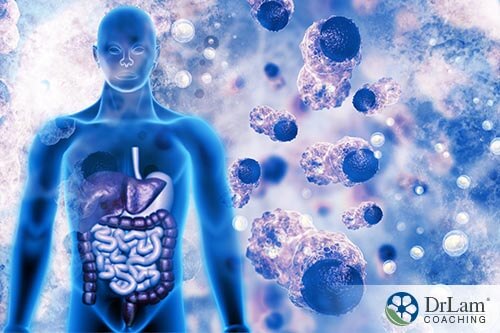 A study looking at the effects of indomethacin – a very strong NSAID – on the intestinal microvilli of mice gave one group of mice water with bovine colostrum before giving them the indomethacin, while the second group was given the indomethacin without being given colostrum at all. The group that was not given colostrum showed significant damage to their microvilli, while the other group showed much less damage.
A study looking at the effects of indomethacin – a very strong NSAID – on the intestinal microvilli of mice gave one group of mice water with bovine colostrum before giving them the indomethacin, while the second group was given the indomethacin without being given colostrum at all. The group that was not given colostrum showed significant damage to their microvilli, while the other group showed much less damage.
Microvilli provide more surface area in the gut, helping to increase absorption of nutrients from food, and when these microvilli get damaged, you get malabsorption. So, if you’ve been on strong pain medications, you’ll likely need to heal your microvilli and increase your absorption.
Research using bovine colostrum whey showed growth and wound healing in the epithelial cells in the gut, which is also important if you’ve been exposed to toxins or taking medications for a while.
It is very important for you to keep in mind that colostrum is a dairy product. If bovine colostrum is harvested too long a time after the birth of a calf, milk is beginning to flow in addition to the colostrum. This can pose a problem for you if you’re allergic to dairy products or are lactose intolerant.
Also keep in mind you get what you pay for with colostrum, just like with any other supplement. The proper processing of colostrum for sale is important. Many of the colostrum products available today are overcooked, over-processed, fat is removed, and they are over-refined to the point of no longer being bioavailable.
Bovine colostrum sourced from hormone-free, grass-fed cows is best, and the supplement should be de-fatted and coated with a mix of phosphatidylserine and choline. That makes it more bioactive, extends its storage life, protects it from oxygenation and stomach acid, and improves its dispersing.
Cooking colostrum supplements removes the probiotic fractions and denatures the fragile immune antibodies and growth factors. Vital fat soluble immune factors can be removed from whole colostrum as well.
In addition, when it comes to bovine colostrum, it is also important to look for a supplement with a good delivery system. That’s because, like some other supplements, it needs to go through the stomach, and if it is not coated properly, as soon as the stomach acid hits it, it will turn into amino acids and lose its important healing abilities.
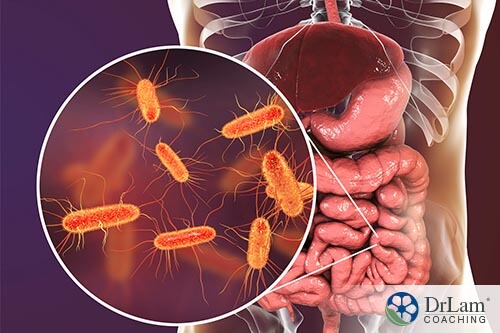 There are a tiny percentage of people that may be sensitive to bovine colostrum, especially if there are other dairy sensitivities, though most people tolerate it well. But as with any medicinal or nutritional change, it’s always best to check with an experienced professional beforehand, especially if you suffer from a chronic condition or your adrenals are weak.
There are a tiny percentage of people that may be sensitive to bovine colostrum, especially if there are other dairy sensitivities, though most people tolerate it well. But as with any medicinal or nutritional change, it’s always best to check with an experienced professional beforehand, especially if you suffer from a chronic condition or your adrenals are weak.
Meanwhile, those with advanced AFS may find colostrum stimulatory in certain situations, resulting in anxiety, insomnia, irritability, fatigue, and adrenal crashes. Always consult your adrenal fatigue-literate provider prior to commencing this nutrient.
That said, bovine colostrum has a mix of autoimmune, immune, and infection protection components. If you use it for those purposes, you’ll also end up with healthy, glowing skin, from the inside out.
Take the first step towards recovery by enrolling in Dr. Lam's Adrenal Fatigue Recovery Program today, and empower yourself with the knowledge and tools you need for a healthier, happier you. In utilizing this program, you could be well on your way to rejuvenation and vitality, so don't wait—your future self will thank you.
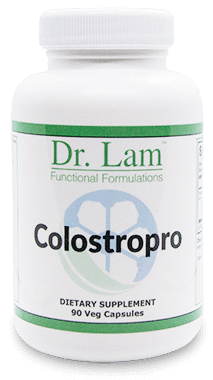
Try Colostropro For Health Inside and Out!
Colostrum is a miracle fluid produced by mammalian breasts during the first few days after a baby is born. It is the first meal many infants get if they are breastfed.
Especially with skin, beauty comes from health, and health starts from the inside. The gut-skin relationship can’t be overstated when trying to get glowing, radiant skin. In this article, you’ll learn how to heal your gut and use bovine colostrum to get the skin you’ve always wanted.
Bovine colostrum also contains lactoferrin. Lactoferrin binds to iron in the gut and keeps it away from bacteria. Many of the gram-negative bacteria in the gut need iron to survive, and so bovine colostrum can help with dysbiosis by keeping the iron away from the bad bacteria, giving the good bacteria a chance to balance out.